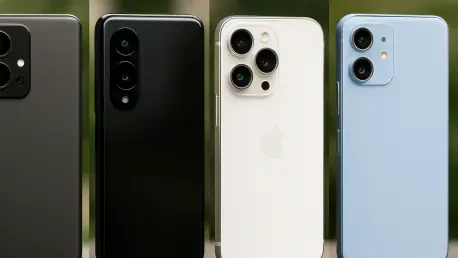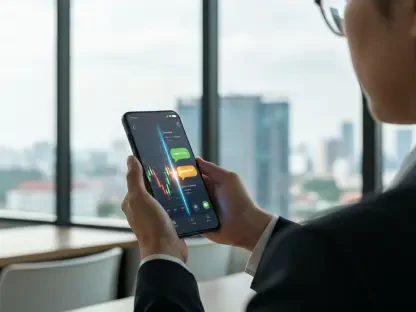In the fast-paced realm of smartphone technology, the battle for photographic supremacy continues to captivate enthusiasts and casual users alike, with the Google Pixel 10 and Apple iPhone 16 Pro Max emerging as two of the most formidable contenders in this arena. Priced at $799 and $1,199 respectively, these flagship devices cater to distinct budgets while promising exceptional camera performance that rivals standalone equipment. A detailed hands-on comparison by a seasoned tech journalist, conducted during a personal staycation, puts these devices to the test across a spectrum of scenarios—from everyday snapshots to challenging low-light conditions and intricate telephoto shots. The central question remains whether the more budget-friendly Pixel 10 can truly stand toe-to-toe with the premium iPhone 16 Pro Max in delivering high-quality images. This matchup isn’t merely a clash of specifications, though both sport impressive 48MP main cameras and 5x optical zoom; it’s about real-world outcomes and the nuances that separate good from great in mobile photography. As the line between mid-range and high-end camera capabilities blurs, this analysis offers critical insights for anyone weighing the balance of cost against cutting-edge quality.
Breaking Down the Camera Systems
Smartphone photography has reached a point where raw specifications often tell only part of the story, and the camera systems of the Pixel 10 and iPhone 16 Pro Max exemplify this trend with strikingly similar hardware foundations. Both devices feature powerful setups, including 48MP main sensors, ultra-wide lenses boasting a 120-degree field of view, and comparable optical zoom capabilities. Yet, despite these parallels, the iPhone frequently edges ahead with images that exhibit richer color tones, superior contrast, and a broader exposure range. These qualities often result in photographs that feel more vibrant and closer to real-life scenes. The Pixel 10, while consistently delivering sharp and detailed captures, occasionally falls short in terms of saturation and dynamic range. This disparity is largely attributed to differences in software processing rather than hardware limitations, highlighting how algorithmic finesse can shape the final output in ways that specs alone cannot predict.
Diving deeper into the practical implications of these camera systems, the distinction becomes even clearer when examining everyday usability across varied shooting conditions. For general photography—think casual street shots or family gatherings—the iPhone 16 Pro Max tends to produce results that instantly impress with their depth and liveliness, often requiring little to no post-editing. The Pixel 10, on the other hand, offers commendable clarity and detail that can satisfy most users, but its output sometimes lacks the same punch in color vibrancy, especially under mixed lighting. This isn’t to say the Pixel falls behind dramatically; rather, it caters to those who might prioritize sharpness over dramatic tonal range. For users who value a polished, out-of-the-box look, the iPhone’s processing gives it a subtle but noticeable advantage, though the Pixel remains a strong contender for those less focused on vivid hues.
Mastering Low-Light Conditions
When daylight fades, smartphone cameras face one of their toughest challenges, and here the Pixel 10 demonstrates remarkable prowess that often surprises given its price point. Equipped with a highly effective Night Sight mode, it excels in low-light portrait photography, producing images with reduced grain and a pleasing bokeh effect that softly blurs backgrounds. Compared to the iPhone 16 Pro Max, the Pixel often delivers clearer nighttime shots, whether capturing the intricate bursts of fireworks or the subtle expressions in dimly lit portraits. This strength makes it an appealing option for anyone who frequently photographs in darker settings, from evening events to late-night urban explorations, without needing to rely heavily on artificial lighting or extensive edits.
Shifting focus to the broader implications of low-light performance, the Pixel 10’s ability to handle such conditions also speaks to its versatility for spontaneous photography. Users can confidently snap shots during a candlelit dinner or a twilight stroll with results that rival much pricier devices. The iPhone 16 Pro Max, while still impressive in low-light scenarios, occasionally introduces more noise in similar settings, which can detract from the overall image quality. This isn’t a dealbreaker by any means, as the iPhone compensates with other strengths, but it underscores how the Pixel punches above its weight in specific niches. For those prioritizing after-hours photography without breaking the bank, the Pixel 10 emerges as a surprisingly robust tool, proving that cost doesn’t always dictate capability in critical shooting environments.
Excelling in Telephoto and Macro Shots
For photographers who crave the ability to zoom in on distant subjects or capture the minutest details up close, the iPhone 16 Pro Max stands out with a clear advantage over its competitor. Its telephoto capabilities benefit from a higher megapixel count in select lenses, paired with superior exposure handling that ensures vivid colors and sharp details even at a distance—think a far-off subject like a turtle rendered with striking greens and yellows. Similarly, in macro photography, the iPhone preserves intricate textures with a precision that makes close-up shots of small objects or natural elements truly stand out. While the Pixel 10 maintains decent sharpness in these scenarios, it often struggles to replicate the same level of color depth and fine detail, particularly at extreme ranges.
Exploring this further, the iPhone’s edge in telephoto and macro photography translates to a more refined experience for specialized use cases, appealing to hobbyists or semi-professionals who demand the best in zoomed or detailed captures. Whether documenting wildlife from afar or focusing on the delicate patterns of a flower petal, the iPhone 16 Pro Max consistently delivers results that feel a cut above, justifying its premium price for those invested in such photography styles. The Pixel 10, while adequate for casual zooming or occasional close-ups, doesn’t quite match this level of finesse, often resulting in images that appear flatter or less dynamic under scrutiny. This gap highlights how specific hardware advantages, combined with optimized processing, can create meaningful differences for users with particular photographic priorities.
Simplifying Panoramic Photography
When it comes to capturing expansive landscapes or wide scenes, the Pixel 10 offers a distinct advantage through its user-friendly approach to panoramic photography. Its interval-based capture method simplifies the process, allowing users to create seamless, high-quality panoramas with minimal effort or technical know-how. This ease of use stands in contrast to the iPhone 16 Pro Max, which employs a more cumbersome process that can sometimes lead to stitching errors or uneven results if not executed with precision. For casual photographers looking to document sweeping vistas during travel or outdoor adventures, the Pixel’s intuitive system proves to be a significant draw, ensuring stunning wide shots without the hassle.
Delving into the practical benefits of this feature, the Pixel 10’s panoramic strength caters especially well to users who value spontaneity and simplicity in their photography toolkit. Whether standing atop a scenic overlook or amidst a bustling cityscape, the ability to quickly and reliably produce a flawless panorama enhances the overall shooting experience. The iPhone, while capable of producing impressive wide shots under ideal conditions, often requires more deliberate effort, which can be a drawback for those less experienced or simply seeking efficiency. This distinction underscores how design choices aimed at accessibility can elevate a device’s appeal, particularly for everyday users who prioritize convenience over complex manual control in specific shooting modes.
Weighing Price Against Performance
A striking $400 price difference between the Pixel 10 at $799 and the iPhone 16 Pro Max at $1,199 prompts a critical evaluation of whether the premium cost translates to a proportional leap in photographic quality. Testing across various scenarios reveals that the Pixel 10 delivers performance that often feels remarkably close to its pricier rival, challenging the assumption that a higher price tag inherently guarantees superior results. In many everyday situations—casual snapshots, social media posts, or quick family photos—the Pixel holds its own with clarity and detail that satisfy most needs. This near-parity suggests that for a significant portion of users, the additional investment in the iPhone may not yield benefits substantial enough to justify the cost.
Reflecting on the broader implications of this price-performance dynamic, it becomes evident that the Pixel 10 represents a shift in how value is perceived in smartphone photography. Budget-conscious consumers, or those who don’t require the marginal improvements offered by the iPhone in niche areas like telephoto detail, find a compelling alternative that doesn’t skimp on core quality. The iPhone 16 Pro Max, while undeniably excellent, often caters to a narrower audience willing to pay for those incremental gains. This narrowing gap between mid-range and premium devices reflects a larger industry trend where advancements in technology are democratizing access to high-quality imaging, allowing users at various price points to achieve professional-grade results without overextending their budgets.
The Role of Software in Image Quality
Beyond the impressive hardware packed into both devices, software processing emerges as a pivotal factor in determining the final quality of photographs taken with the Pixel 10 and iPhone 16 Pro Max. Apple’s algorithms are often tuned for exceptional color accuracy and exposure balance, lending the iPhone’s images a refined, polished look that stands out in side-by-side comparisons. Google, meanwhile, focuses on clarity and user-friendly features, as seen in tools like its panoramic capture system. These processing differences frequently play a more decisive role than hardware specs alone, shaping how each device interprets lighting, tones, and textures in real-world scenarios, and ultimately influencing user satisfaction.
Taking a closer look at how software impacts specific outcomes, it’s clear that these behind-the-scenes adjustments can either elevate or limit a camera’s potential, depending on the manufacturer’s priorities. For instance, the iPhone 16 Pro Max consistently handles complex lighting with a finesse that enhances sunset hues or intricate indoor scenes, while the Pixel 10 leans toward sharp, straightforward rendering that sometimes sacrifices vibrancy for detail. This contrast reveals a philosophical divide in approach—Apple aims for artistic flair, while Google emphasizes practicality. For users, understanding that software can tip the scales as much as megapixels or lens quality offers a deeper perspective on why two devices with similar specs might produce noticeably different results.
Reflecting on a Tight Photographic Race
Looking back at the head-to-head comparison between the Google Pixel 10 and iPhone 16 Pro Max, it became apparent that both devices brought formidable strengths to the table in the realm of smartphone photography. The iPhone 16 Pro Max, with its $1,199 price tag, clinched a slight overall victory through vibrant color depth, standout telephoto and macro capabilities, and nuanced exposure handling that appealed to enthusiasts chasing perfection. Meanwhile, the Pixel 10, priced at $799, proved itself as a budget-friendly powerhouse, matching its rival in sharpness, excelling in low-light portraits, and offering an unmatched panoramic experience.
As a next step, potential buyers should weigh their specific photography needs against their budget constraints to determine the best fit. Those focused on specialized shots like extreme zooms or intricate close-ups might find the iPhone’s premium features worth the splurge, while users seeking value and versatility for everyday use could confidently opt for the Pixel 10. Exploring hands-on demos at retail locations or diving into user forums for real-world feedback can further clarify which device aligns with individual priorities, ensuring a choice that maximizes both satisfaction and practicality in capturing life’s moments.









